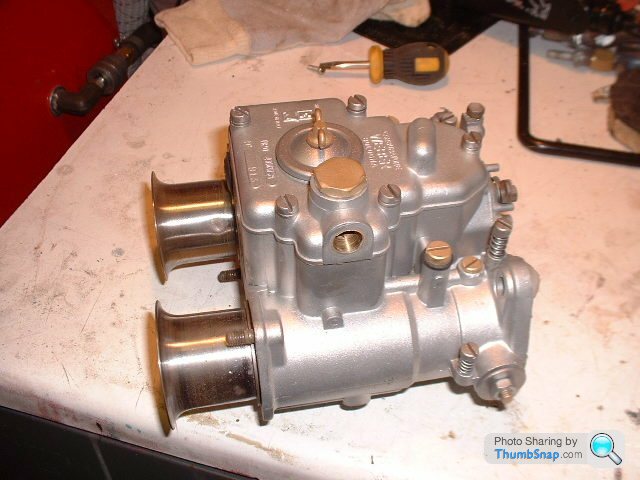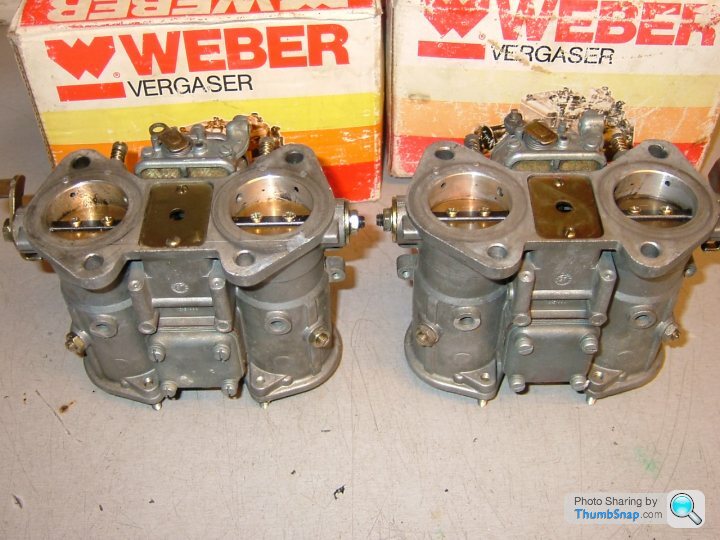Removing and servicing Weber DCOE's
Discussion
My Westfield misfires on sharp right-hand corners, which started not long after I had the carbs set up. This is followed by a smell of fuel. I had the garage that set the carbs up take another look and they replaced a gasket and cleared some gunk out but the problem persists and I now think I get a faint fuel smell when coasting with a closed throttle. The garage claimed that after they had worked on the car they couldn't get it to misfire. Unfortunately the first roundabout was nearly back home and I couldn't be bothered to go back again. So that brings me to where I am now.
I'm a total mechanics novice (I bought the Westield to learn) but I want to have a go at servicing the carbs. Ie bought a Weber service kit for each and I'm going I can work through simply peeling gaskets off, cleaning and replacing with one that matches! Any advice on this front would be appreciated! I'm also keen that I don't spill a ton of fuel in the garage, so any advice on removing the carbs from the manifold (may also remove this) would also be appreciated!
I'm a total mechanics novice (I bought the Westield to learn) but I want to have a go at servicing the carbs. Ie bought a Weber service kit for each and I'm going I can work through simply peeling gaskets off, cleaning and replacing with one that matches! Any advice on this front would be appreciated! I'm also keen that I don't spill a ton of fuel in the garage, so any advice on removing the carbs from the manifold (may also remove this) would also be appreciated!
OK - I am not an expert on Webers, although I too had a Westfield that ran these carbs, a few years ago. You say that it happens on RIGHT-hand corners.... OK - I assume that it does not happen on LEFT-hand corners... therefore it is highly likely to be something to do with the way the fuel is sloshing in the float bowls... it is causing starvation when it sloshes one way, but not the other. Possibly the float bowls are not filling up with enough fuel....
I would check the fuel pressure first. Do you have a gauge in your car ? If not, you can (with a COLD engine, for safety) remove the fuel pipe and see how long it takes to fill a known capacity container (you will need to find out what the requirement is for your particular engine)
I would do that before thinking that the carb needs stripping or any gaskets replacing. I hope this helps and will get you off and running in your quest to solve the problem.
Regards
I would check the fuel pressure first. Do you have a gauge in your car ? If not, you can (with a COLD engine, for safety) remove the fuel pipe and see how long it takes to fill a known capacity container (you will need to find out what the requirement is for your particular engine)
I would do that before thinking that the carb needs stripping or any gaskets replacing. I hope this helps and will get you off and running in your quest to solve the problem.
Regards
I agree with the above- it's likely to have something to do with float levels. I don't know how to re-set them though.
Regarding servicing the carbs, make sure you've got a nice broad flat-blade screwdriver for unscrewing the jets. Replace the carburetor to manifold 'O'-rings or seal plates. Check the throttle return springs. Check the spindles for play or tightness, and lighly lubricate them. Finally, remember not to over-tighten the carb-manifold bolts / thrackery washers.
Regarding servicing the carbs, make sure you've got a nice broad flat-blade screwdriver for unscrewing the jets. Replace the carburetor to manifold 'O'-rings or seal plates. Check the throttle return springs. Check the spindles for play or tightness, and lighly lubricate them. Finally, remember not to over-tighten the carb-manifold bolts / thrackery washers.
as above, check the float heights and that the floats don't have fuel in them...
if you are going to take the carbs off, take them off on the manifold if its a Ford Crossflow, its easier.
When stripping them remember they are precision devices, dont force things. get some good screwdrivers that fit snug in the screws / jets and are at least as wide as the screw you are removing. If the jets themselves are tight, go easy and if needed, use some Plusgas which is very effective.
Removing and replacing spindles is tricky...
While you are in there, replace the throttle springs, they are prone to breaking and sticking the throttle open!
Before I did anything though, I would check that the chokes are in tight, and that the screw and lock nut underneath is in place and tight (slacken the lock nut, tighten the screw and re tighten the nut ... make sure the choke is located correctly) I have seen loose chokes cause the misfire you describe.
here are a couple of shots of a before and after rebuild, I have done dozens of these over the years!


if you are going to take the carbs off, take them off on the manifold if its a Ford Crossflow, its easier.
When stripping them remember they are precision devices, dont force things. get some good screwdrivers that fit snug in the screws / jets and are at least as wide as the screw you are removing. If the jets themselves are tight, go easy and if needed, use some Plusgas which is very effective.
Removing and replacing spindles is tricky...
While you are in there, replace the throttle springs, they are prone to breaking and sticking the throttle open!
Before I did anything though, I would check that the chokes are in tight, and that the screw and lock nut underneath is in place and tight (slacken the lock nut, tighten the screw and re tighten the nut ... make sure the choke is located correctly) I have seen loose chokes cause the misfire you describe.
here are a couple of shots of a before and after rebuild, I have done dozens of these over the years!


the screw and locknut can be seen in this picture...
Also remove the plates with the two screws and replace the springs! they do break and if you are lucky the bottom eye breaks and the spring just hangs there... if you are unlucky, the top eye breaks and the spring drops down and jambs the throttle open
Most people who race remove the altogether and use external springs...
The official float heights for the Webers are 8mm (round brass floats) and 14mm (black plastic floats). If you use the settings for the wrong type of floats you will be in the sticky and smelly.
It is quite common to vary the heights a little. Typically people use 12 - 13mm for the plastic variety.
These figures are for the float height when the needle valve has JUST shut. The little spring loaded ball in the needle valve must NOT be compressed. It is easiest to do this by holding the carb top vertically with the float pivot at the top.
Note that the height is with the gasket in place.
It is quite common for the older brass floats to become punctured and fill with fuel. This creates merry hell with the fuelling and should be checked. The black floats are made of a sort of rigid plastic Aero Bar and are therefore unpuncturable to all intents and purposes.
Fuel pressure will ideally be 3 - 4psi.

Also remove the plates with the two screws and replace the springs! they do break and if you are lucky the bottom eye breaks and the spring just hangs there... if you are unlucky, the top eye breaks and the spring drops down and jambs the throttle open

Most people who race remove the altogether and use external springs...
The official float heights for the Webers are 8mm (round brass floats) and 14mm (black plastic floats). If you use the settings for the wrong type of floats you will be in the sticky and smelly.
It is quite common to vary the heights a little. Typically people use 12 - 13mm for the plastic variety.
These figures are for the float height when the needle valve has JUST shut. The little spring loaded ball in the needle valve must NOT be compressed. It is easiest to do this by holding the carb top vertically with the float pivot at the top.
Note that the height is with the gasket in place.
It is quite common for the older brass floats to become punctured and fill with fuel. This creates merry hell with the fuelling and should be checked. The black floats are made of a sort of rigid plastic Aero Bar and are therefore unpuncturable to all intents and purposes.
Fuel pressure will ideally be 3 - 4psi.

Edited by buzzer on Friday 29th March 10:32
Thanks for the helpful advice. With the aid of a GoPro I've spotted a fairly major leak from the col start area of the carbs. So I've removing the cable etc and fitting two blanking plates. I'm going to do this in situ before I remove anything.
EDIT: This is the video: http://www.youtube.com/watch?v=M0wbOEiNXnM
The leak is fairly easy to spot. The car is also very hesitant when given full throttle from idle while stood still. Not sure why that could be, but as I said above I'm going to remove the cold start mechanism and see where we are.
EDIT: This is the video: http://www.youtube.com/watch?v=M0wbOEiNXnM
The leak is fairly easy to spot. The car is also very hesitant when given full throttle from idle while stood still. Not sure why that could be, but as I said above I'm going to remove the cold start mechanism and see where we are.
Edited by m444ttb on Sunday 31st March 08:55
There shouldn't be any fuel as high as the cold start mechanism, check for a leaky float or float level too high. Take the air filter off , turn on fuel pump and check for fuel leaking out of the aux choke/s, this is without the engine running. Also check that the O rings on the Misab plates are not perished.
Edited by jagracer on Sunday 31st March 09:49
Gassing Station | Home Mechanics | Top of Page | What's New | My Stuff



